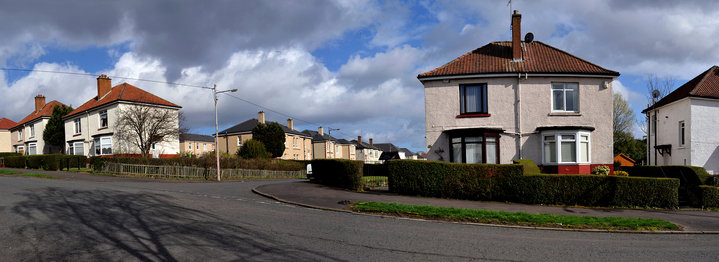Carntyne

There were 15 different areas in Glasgow included in GoWell – one of which was Carntyne. The map shows the study area boundaries for Carntyne.
We did not include the entire neighbourhood of Carntyne in our study, but rather an outer ring of streets as shown on the above map. This is because the streets in the centre of Carntyne contain homes referred to as ‘Wingets', which were not included in our study as they were being treated as a ‘Special Project Area' by Glasgow Housing Association.
Why
We were interested in Carntyne because it was part of the community regeneration programme that took place in Glasgow. This involved both internal and external improvements to people's homes and efforts to support communities with improved services and amenities. These activities provided an opportunity to find out from local residents if and how their health and lives changed as a result of investment in their homes and their neighbourhood.
What
We carried out a number of resident surveys over our 14-year study. These consisted of interviews conducted face-to-face in people’s homes and included a whole range of questions about how people felt about their homes, their neighbourhood, services in the area, their lifestyle and circumstances and their health and wellbeing.
Over time this helped us understand more about the process of neighbourhood regeneration, and to highlight what was working well for communities and what needed more attention.
If you were involved in one of our surveys you can find additional information about your participation here.
We conducted four surveys in Carntyne: in 2006 in which 336 residents were interviewed; 2008 in which 267 residents were interviewed; 2011 in which 247 residents were interviewed; and 2015 in which 213 residents were interviewed. In total, 1,063 interviews took place.
Findings
A small selection of findings from these four surveys with Carntyne residents are shown below:
- In 2015, 90% of residents were satisfied or very satisfied with their home. This has remained relatively stable, as it was 89% in 2006.
- In 2015, 90% of participants were very or fairly satisfied with their neighbourhood as a place to live. This had increased from 85% in 2006.
- 77% of participants felt part of their community in 2015. This has reduced from 84% in 2008, when this question was first asked.
- 68% of participants rated their general health as excellent, good or very good in 2015. This was a small decline from 65% in 2006.
- In terms of empowerment, 41% of participants in 2015 felt that on their own, or with others, they could influence decisions affecting their local area. This has fallen from 50% in 2006.
Over the 14 years study we widely shared and discussed the findings from the community surveys with various service providers across Glasgow to encourage them to consider the findings when planning and prioritising services and amenities. They were used by a wide range of stakeholders including local communtiies, housing and regeneration organisations and local and national government.
We also regularly summarised and shared the area findings with the communities involved through our community newsletters. The last newsletter for this area can be accessed below.